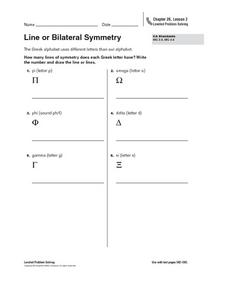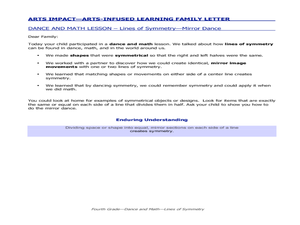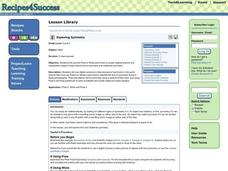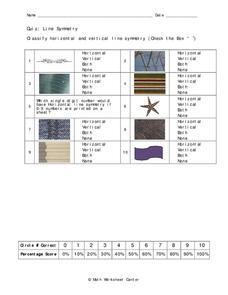Curated OER
Line or Bilateral Symmetry
In this problem solving worksheet, 4th graders figure out how many lines of symmetry 6 Greek alphabet letters have. Students write each number and draw the line or lines on the lines provided.
Curated OER
Symmetry
Students explore symmetry. In this geometry lesson, student identify and define bilateral symmetry, radial symmetry, pentagonal symmetry, hexagonal symmetry, and cubic symmetry. Students construct examples of these types of symmetry and...
Curated OER
Reflections of Symmetry
Students use video and the Internet to identify examples of bilateral and radial symmetry in the world around them. They create symmetrical reflection designs using pattern blocks and paper.
Curated OER
Lines of Symmetry - Mirror Dance
Fifth graders analyze how to divide space or shape into mirror sections to create lines of symmetry. In this lines of symmetry instructional activity, 5th graders discuss symmetry in dance, math, and living. Students participate in a...
Curated OER
Lines of Symmetry
Students practice dance to divide the space or body shape into equal sections to create symmetry in dance. For this symmetry lesson, students practice symmetrical and asymmetrical movements in dance. Students participate in move and...
Curated OER
Invertebrate Diversity
Comparative anatomy prevails in the lesson exploring diversity among invertebrates. Biologists examine physical characteristics of an earthworm from phylum annelida and a meal worm from phylum insecta. They also inspect a cricket and a...
Curated OER
Exploring Symmetry
Students use a software program to create artwork and to manipulate images to study mirror and rotational symmetry. They take pictures of items in their environment in which they identify symmetry.
Curated OER
A World of Symmetry
Students identify lines of symmetry. For this symmetry lesson, students create objects and identify their lines of symmetry. They answer questions about lines of symmetry. Students cut shapes out of cookie dough and...
Curated OER
Creating and Destroying Symmetry
Students study the types of symmetry that appear in different basketball symbols. They point out changes that rotate symmetry from one type to another.
Curated OER
What is an animal?
For this animal worksheet, students determine which characteristic of an animal matches the given statement. Students describe illustrations of animals using the terms radial symmetry, bilateral symmetry, and no symmetry.
Curated OER
What's the Difference?
Students analyze the similarities in different species. This lesson is part of a multi-segmented unit on the diversity of life. In this segment, students classify shoes to mimic the scientific categories of the classification system.
Columbus City Schools
Get Your Organisms Organized
From large to small, show your class how to organize them all! Included within the guide is everything you need to take their knowledge of classification from the cellular to the species level. The worksheets focus on...
Curated OER
Science and Math Lab (Students Look at Symmetry in Nature)
Students study patterns. In this symmetry in nature lesson plan, students examine objects to determine what type of symmetry they have. They work in small groups to rotate through stations that have objects for them to study.
Curated OER
Symmetry in Butterflies
Students create a butterfly displaying a mirror image of itself to show that it is symmetrical. In this symmetry lesson plan, students go over symmetry in different shapes and identify patterns in butterflies.
Curated OER
Side by Side: Butterfly Wings and Symmetry
Students observe butterfly images and then draw and paint their own design. They use this activity to explain symmetry.
Curated OER
A Side View
In this animal symmetry worksheet, students label organisms by the type of body symmetry that organism has. Then students draw an example of each type of symmetry. This worksheet has 3 drawings and 21 fill in the blank questions.
Curated OER
The Phylogenetic Tree
In this biology learning exercise, students label parts of a phylogenetic tree and differentiate between bilateral symmetry and radial symmetry.
Curated OER
Invertebrate Diversity
Students observe different animals with bilateral symmetry. In this biology instructional activity, students compare how these animals move. They discuss the evolutionary history of observed animals.
Curated OER
Invertebrate Phyla
Students explore the invertebrate phyla. They discuss the characteristics of the invertebrate Phyla in the Kingdom Animal. Students classify organisms into Phyla based on their characteristics. They distinguish radial symmetry, bilateral...
Curated OER
Flatworms
For this flatworms worksheet, students will review the characteristics of planarians, tapeworms, and flukes. This worksheet has 5 true or false, 2 short answer, and 7 matching questions.
Curated OER
Mollusks
In this mollusks learning exercise, students will review the characteristics of the three major classes of mollusks: gastropods, bivalves, and cephalopods. This learning exercise has 17 matching, 6 short answer, 9 fill in the blank, and...
Curated OER
Line Symmetry
In this line symmetry worksheet, 10th graders solve 10 different problems related to various forms of line symmetry. They classify each line of symmetry illustrated as horizontal, vertical, both, or neither. Then students check the...
Radford University
Google Earth Trip
A trip around the world sounds nice, but for now we'll just have to make do with Google Earth. Pupils use pictures of landmarks to apply geometry concepts. They determine whether each building has bilateral or rotational symmetry, search...
Curated OER
Invertebrates
Middle schoolers examine invertebrates. In this animal classification lesson, students discuss invertebrates and bilateral symmetry. They discuss the importance of horse shoe crabs in medical science.
Other popular searches
- Bilateral Symmetry Starfish
- Radial Bilateral Symmetry
- Animal Bilateral Symmetry
- Butterfly Bilateral Symmetry
- Symmetry Bilateral

























